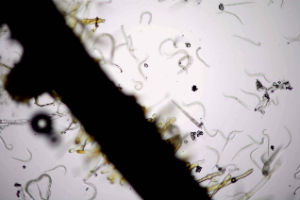 Mobilisation of soil phytate reserves: what are the key factors for unlocking the phosphorus of this treasure ?
Mobilisation of soil phytate reserves: what are the key factors for unlocking the phosphorus of this treasure ?
Plants assimilate phosphorus (P) only from inorganic phosphate (Pi) present in very low concentrations in the soil and, therefore, limiting for plant growth. However, soil contains an abundant supply of phytate which is very rich in P but unavailable to plants. This project sets out to find strategies that enable plants to assimilate the P from phytate. How can the reserves of phosphorus in the phytate buried in the soil be released to plants ?
The project sets out to find solutions to the “P crisis” that is likely to affect agriculture in less than a century. It evaluates 2 strategies that could enable plants to make better use of the phytate in soil.
- The ecological strategy evaluates the efficiency of the association of symbiotic mycorrhizal fungi (able to extract inorganic phosphate, unable to use the phytate) with phytate mineralising bacteria and their predators.
- The biotechnological strategy attempts to make mycorrhizal fungi able to mineralise the phytate directly.
The UnlockP project is based on an ecological strategy and sets out to discover how to accelerate the mineralization of organic P (phytate) for plants ?
Aims
The project is designed to determine whether, on the one hand, it is possible to improve the functioning of the trophic transfer between the bacteria which can mineralise phytate and their predators which release bacterial P and whether, on the other, it is possible for plants associated with symbiotic mycorrhizal fungi to benefit directly.
Methodologies
Te project will use genetic engineering to produce 3 phytases from 2 species of fungi and one bacteria. These phytases will then be used in soil where the appearance of inorganic phosphate is monitored by various methods. We will also produce strains of mycorrhizal fungi that can release these 3 enzymes directly. We will compare the amount of P accumulated in plants inoculated with phytate mineralising bacteria and their predators with that accumulated in these new strains.
Initial results and outlook
The initial results show that adding fungal phytase to soil amended with phytate can significantly increase the quantity of inorganic phosphate. These results are encouraging as they suggest that these enzymes could increase the release of P from the phytate present in agricultural residues (pig slurry in particular), which would improve the recycling of this type of agricultural waste.
All the results will be integrated into a mathematical model. The production of this new model should enable us to improve the prediction of the fate of phytate added to the soil by agricultural activities, showing in particular what actions should be taken to enable plants to assimilate the P contained in phytate. This final stage is particularly important to reduce the use of mineral P fertilisers in agriculture.
Date 
2012-2016
Partners
- UMR 7312 Université de Reims
- UMR SPO (Sciences pour l'oenologie), Inra Montpellier
- UMR IATE (ingéniérie des agropolymères et des technologies émergentes), Cirad, Montpellier II, Inra, Montpellier SupAgro
Funding
ANR
Contact
Claude Plassard, Eco&Sols, INRA Montpellier
e-mail :






